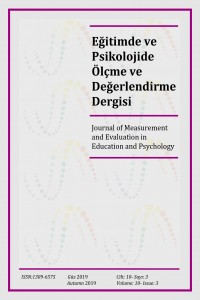Abstract
References
- Cohen, L., Manion, L., & Morrison, K. (2002). Research methods in education. London; Routledge.
- Fish, L. J. (1988). Why multivariate methods are usually vital. Measurement and Evaluation in Counseling and Development, 21, 130-137.
- Glenn A. Bowen. (2009). Document Analysis as a Qualitative Research Method. Qualitative Research Journal, 9 (2), 27-40.
- Huberty, C. J., & Morris, J. D. (1989). Multivariate analysis versus multiple univariate analysis. Psychological Bulletin, 105, 302-308.
- Hummel, T. J., & Sligo, J. R. (1971). Empirical comparison of univariate and multivariate analysis of variance procedures. Psychological Bulletin, 76, 49-57.
- Kieffer, K. M., Reese, R. J., & Thompson, B. (2001). Statistical techniques employed in AERJ and JCP articles from 1988 to 1997: A methodological review. Journal of Experimental Education, 69, 280-309.
- R Core Team (2013). R: A language and environment for statistical computing. R Foundation for Statistical Computing, Vienna, Austria. URL http:www.R-project.org/.
- Sherry, A. (2006). Discriminant analysis in counseling psychology research. The Counseling Psychologist, 34, 661-683.
- Stevens, J. P. (2002). Applied multivariate statistics for the social sciences. Mahwah, NJ: Lawrence Erlbaum Associates.
- Tonidandel, S., & LeBreton, J. M. (2013). Beyond step-down analysis: A new test for decomposing the importance of dependent variables in MANOVA. Journal of Applied Psychology, 98, 469-477.
- Venables, W. N. & Ripley, B. D. (2002) Modern Applied Statistics with S. Fourth Edition. Springer, New York. ISBN 0-387-95457-0
- Warne, R. T. (2014). A primer on multivariate analysis of variance (MANOVA) for behavioral scientists. Practical Assessment, Research & Evaluation, 19(17), 1-10.
- Warne, R. T., Lazo, M., Ramos, T., & Ritter, N. (2012). Statistical methods used in gifted education journals, 2006-2010. Gifted Child Quarterly, 56, 134-149.
- Zientek, L. R., & Thompson, B. (2009). Matrix summaries improve research reports: Secondary analyses using published literature. Educational Researcher, 38, 343-352.
Abstract
ANOVA and MANOVA
address different research questions and decision on conducting one or the
other of these tests relies on the research purpose. One prominent illegitimate
analysis of multivariate data is developed out of conducting multiple ANOVAs
rather than conducting a MANOVA. Another common mistake about MANOVA
applications is the use of improper post hoc procedure. Post hoc procedures are
needed to determine why the null hypothesis was rejected. Although the correct
post hoc procedure for MANOVA is descriptive discriminant analysis (DDA), many
researchers fail to conduct DDA to interpret their MANOVA results. The purpose
of this study is two-fold; (1) we aim to emphasize the theory behind the MANOVA
and its appropriate post hoc procedure and make clear distinction between
surrogate statistical procedures such as ANOVA; and (2) this study also
investigates the extent of incorrect analysis of multivariate dependent
variables in educational research in Turkey. First, we provided a small
simulation study to demonstrate the extent to which multiple ANOVAs yields
contradictory results when they are inadvertently used to test group mean
differences on multiple dependent variables. Results of the simulations
indicated that MANOVA and multiple ANOVAs had severe disagreements under many
conditions. Disagreement rate is elevated under the conditions where MANOVA
retains the null hypothesis. Then, we systematically reviewed the archives of
three education journals, which are classified as higher-, medium, and lower
quality journals. Results indicated that correct use of MANOVA with its proper
post hoc procedure is not common practice across educational researchers who
publish in Turkish education journals.
References
- Cohen, L., Manion, L., & Morrison, K. (2002). Research methods in education. London; Routledge.
- Fish, L. J. (1988). Why multivariate methods are usually vital. Measurement and Evaluation in Counseling and Development, 21, 130-137.
- Glenn A. Bowen. (2009). Document Analysis as a Qualitative Research Method. Qualitative Research Journal, 9 (2), 27-40.
- Huberty, C. J., & Morris, J. D. (1989). Multivariate analysis versus multiple univariate analysis. Psychological Bulletin, 105, 302-308.
- Hummel, T. J., & Sligo, J. R. (1971). Empirical comparison of univariate and multivariate analysis of variance procedures. Psychological Bulletin, 76, 49-57.
- Kieffer, K. M., Reese, R. J., & Thompson, B. (2001). Statistical techniques employed in AERJ and JCP articles from 1988 to 1997: A methodological review. Journal of Experimental Education, 69, 280-309.
- R Core Team (2013). R: A language and environment for statistical computing. R Foundation for Statistical Computing, Vienna, Austria. URL http:www.R-project.org/.
- Sherry, A. (2006). Discriminant analysis in counseling psychology research. The Counseling Psychologist, 34, 661-683.
- Stevens, J. P. (2002). Applied multivariate statistics for the social sciences. Mahwah, NJ: Lawrence Erlbaum Associates.
- Tonidandel, S., & LeBreton, J. M. (2013). Beyond step-down analysis: A new test for decomposing the importance of dependent variables in MANOVA. Journal of Applied Psychology, 98, 469-477.
- Venables, W. N. & Ripley, B. D. (2002) Modern Applied Statistics with S. Fourth Edition. Springer, New York. ISBN 0-387-95457-0
- Warne, R. T. (2014). A primer on multivariate analysis of variance (MANOVA) for behavioral scientists. Practical Assessment, Research & Evaluation, 19(17), 1-10.
- Warne, R. T., Lazo, M., Ramos, T., & Ritter, N. (2012). Statistical methods used in gifted education journals, 2006-2010. Gifted Child Quarterly, 56, 134-149.
- Zientek, L. R., & Thompson, B. (2009). Matrix summaries improve research reports: Secondary analyses using published literature. Educational Researcher, 38, 343-352.
Details
| Primary Language | English |
|---|---|
| Journal Section | Articles |
| Authors | |
| Publication Date | September 4, 2019 |
| Acceptance Date | May 30, 2019 |
| Published in Issue | Year 2019 Volume: 10 Issue: 3 |


